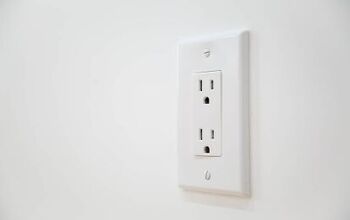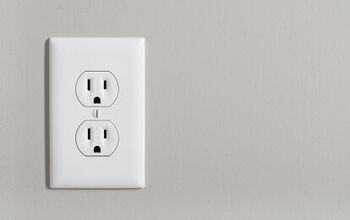How Many Receptacles Can Be On A 20 Amp Circuit?

Wiring branch circuits in your home can be complicated and a bit tricky. There are numerous codes and regulations to consider as you install the circuit breakers, wiring, receptacles and lighting fixtures. One issue requiring more than a little attention is the number of receptacles installed on a 20-amp branch circuit.
A 20-amp circuit can theoretically safely supply 13 outlets. Thirteen outlets are based on the calculations set out in NEC Article 220.14(I). However, thirteen outlets on a single 20-amp circuit don’t meet recommendations of the NEC to limit branch circuit loading to 80% of its rated capacity. This recommendation would limit a 20-amp branch circuit to ten outlets.
Certain exceptions allowed in the NEC allow more than ten receptacles on a 20-amp branch circuit. The NEC code also has stipulations that can require fewer than ten receptacles on some branch circuits. Understanding and applying the NEC codes can be complicated and overwhelming. Learning more about the requirements for outlets on branch circuits can keep you and your home safe.
Why Are There Limits on the Number of Outlets on a 20-amp Circuit
Limiting the number of outlets on a 20-amp circuit or any circuit is a matter of safety. Overloading an electrical circuit can cause the branch circuit’s wires to overheat. AN overloaded branch circuit may also suffer electrical surges. Either of these situations can lead to fires that can be devastating for your family and home.
According to the National Electric Code (NEC), Article 220.18 specifies the maximum load shall not exceed the rating of the branch circuit. In Article 220.14(I), the NEC sets the minimum load calculation per branch circuit using 1.5-amps to determine the number of outlets that the branch circuit can supply
Where Are 20-Amp Circuits Required in a Home Electrical System?
Normally, branch circuits in a residential structure are protected by a 15-amp breaker, limiting the service to those outlets to 15-amps. However, the National Electrical Code requires 20-amp branch circuits in certain places and applications. In some instances, the 20-amp branch circuits may only have one receptacle.
Kitchens
Under the current edition of the NEC, a kitchen requires two 20-amp circuits serving the kitchen’s countertops. This requirement ensures that there is enough power for various countertop appliances such as microwaves, toasters and blenders.
Many of these appliances need a much higher amperage at startup. A 20-amp circuit will provide a margin of safety in the branch circuit serving the kitchen to prevent electrical problems.
Under some local building codes, a dedicated 20-am circuit is required to service refrigerators and microwave ovens. These larger appliances require higher amp draws than other appliances when they start. You should check your local building code for other requirements for electrical branch circuits in kitchens.
Laundry Rooms
The National Electrical Code calls for at least one 20-amp branch circuit to serve a laundry room. The 20-amp branch circuit is necessary for the washing machine. Other requirements may also come into play in a laundry room. A dedicated 30-amp, 240-volt circuit is required to provide power to an electric clothes dryer.
Another NEC requirement for the branch circuits in a laundry room is the protection of the circuit by a GFCI outlet or circuit breaker. GFCI protection is required on all branch circuits in wet or damp locations.
Garages
Garage spaces have some special requirements under the NEC. Since the publication of the 2017 edition of the NEC, garage spaces are required to have at least one dedicated 120-volt 20-amp branch circuit that services only the garage space. Outlets in other rooms cannot be part of a multi-outlet garage circuit.
The outlets on the dedicated garage branch circuit must have GFCI protection. On the dedicated circuit in the garage, there must be at least one receptacle for each car space in the garage.
Bathrooms
Bathrooms, for their size, often require much more electrical power than you might think. Electric heating, powerful appliances such as blow dryers, and other appliances can create a high demand for electrical service. For these reasons, bathrooms have some special requirements under the NEC.
In general, the electrical outlets serving a bathroom must be on a 20-amp circuit. This circuit can also serve the lighting in the bathroom. However, no other appliances such as vent fans with electrical heating can be on this branch circuit.
Depending on the size of the electric heating unit in a vent fan, the vent fan/heater may require its own 20-amp dedicated circuit. There may be other requirements if the branch circuit also serves lighting fixtures in damp locations such as a shower or wet sauna.
What is the Best Type of Outlet for My Circuit?
The key to choosing which type of outlet should be in your electrical branch circuit systems is your local building code. If you live in an area that is not governed by a local building code, you should follow the recommendations of the National Electrical Code
In General, these are the recommendations of the National Electrical Code. Most local building codes are modeled after the NEC or other internationally recognized electrical codes. For the most part, all of the recognized codes are the same, with a few minor variations.
Is it Permissible to Put a 15-Amp Outlet in a 20-Amp Circuit?
There is no prohibition against putting a 15-amp receptacle in a 20-am circuit. However, this practice is not recommended. Should a homeowner manage to plug a 20-amp appliance into a 15-amp receptacle, even if the receptacle is on a 20-amp circuit, the receptacle can overheat and create a problem.
Receptacles are constructed differently to prevent larger amperage appliances from being used in smaller amperage systems. In general, 20-amp receptacles have a T-shaped prong on the verticle part of the plug. Fifteen amp outlets lack the T-shaped plug. This usually prevents a 20-amp appliance from being plugged into a 15-amp circuit.
Does Every Circuit Need GFCI Protection?
According to the National Electric Code, only certain living areas in your home need GFCI protection. Specifically, the NEC in Article 210.8 Ground -Fault Circuit -Interrupter Protection for Personnel Subsection (A) Dwelling Units lists the living areas that require GFCI protection.
- Bathrooms
- Garages and also accessory building that have a floor located at or below grade level
- Outdoors
- Crawl spaces
- Basements
- Kitchens
- Sinks
- Boathouses
- Bathtubs and shower stalls
- Laundry areas
It is clear that most areas of a home are exempt from the code requirement for GFCI protection. However, with the availability of GCI circuit breakers, the cost is manageable enough to install GFCI circuit breakers on every branch circuit in your home. This adds a significant level of protection for your home and family.
Do I Need to Upgrade My 15-Amp Circuit into a 20-Amp?
Many owners of older homes experience an increased number of circuit breakers trips as their homes get older. There are several reasons for this. Some of these problems may only be solved by upgrading a 15-amp circuit to a 20-amp circuit. Before you begin planning such an upgrade, consider these factors.
Modern Appliances and Electronics May Require More Amps
If your home is more than a few years, old technologies may have surpassed the capacity of some of your electrical system branch circuits. Newer appliances are larger and more energy demanding. These higher amperage needs can overload circuits easily.
You may need to consider upgrading certain branch circuits with larger appliances, electronics, or power tools trip the circuit breakers regularly. Your older home may have 15-amp branch circuits wired with 14-gauge wire that just can’t handle the loads.
Older Homes may have Inadequate Wire Size
The loads expected many years ago were much lower than what we use today. Older homes may have inadequate-sized wire in the branch circuits. This often leads to circuit breaker trips as we add larger and newer electronics and appliances. If this is the case, an upgrade to your wiring system may be in order.
Your Circuit Breakers May Need a Look
Circuit breakers, like any mechanical device, can wear out. Over time, older circuit breakers may become prone to tripping or may fail to work at all. In general, circuit breakers have a life span of between 30 and 40 years. If your home is approaching this age, it may be time to consider upgrades to the branch wiring circuits and circuit breakers.
The Downside of Upgrading a 15-amp Circuit to 20-Amps
Unfortunately, rewiring a residential structure is a major project. Upgrading a 15-amp circuit to 20-amps requires pulling new wire throughout your home. 15-amp circuits are usually wired with a smaller gauge wire than 20-amp circuits. You cannot simply change out the outlets and the breakers. The wire must be of the right size to handle the higher amperages.
All too often, this kind of upgrade involved removing wall coverings to expose the wiring. Upgrading circuits are expensive, time-consuming, and inconvenient. However, it can add to the value of your home and make it safer for you and your family.
Managing your Home’s Electrical System
It is vital to know and understand your home’s electrical system components. To avoid problems, know which branch circuits are 15-amp and 20-amp circuits. There are some tips that you can use to keep you, your home, and your family safe.
You may not need to use all of these ideas, but they can make the job of managing and maintaining your home’s electrical system easier and quicker. As the homeowner, it is up to you to decide what steps you need to take to maintain your home’s electrical system.
Identify Each Branch Circuit and Mark it Clearly
Each branch circuit in your electrical system should have its own circuit breaker. A diagram of your home’s electrical system can be invaluable in locating problems when they occur. The diagram should identify the branch circuit, the size of the breaker serving the circuit, and if it is a GFCI or not. In addition, the layout plan should note the location of each receptacle and light fixture in the circuit.
Total the Electrical Load on Each Branch Circuit
You should survey each branch circuit and total the electrical load plugged into the outlets on that circuit. You may never expect that every appliance plugged in will be used simultaneously, but there is a possibility that this may happen. The total load on the circuit should never exceed the rating of the circuit.
If there are situations where you must have more electrical service than the current system can supply, changes must be made. You should consult with a qualified licensed electrician about adding additional circuits to your home to handle the additional requirements.
Avoid the Use of Multi-Plug Outlet Extensions or Plug Strips
One of the largest problems with overloaded electrical branch circuits is using multi-plugs to add additional outlet space. This quickly leads to overloads on the system that must be avoided. Many electrical fires in homes with otherwise safe electrical systems are traced to multi-plugs to overload the system. If you find it necessary to add multi-plugs to your electrical system, you should talk to your electrician about adding additional branch circuits rather than piling on multi-plugs.
Outlets on a 20-Amp Branch Circuit – Keeping Your Home Safe
In general, the National Electrical Code limits the number of 20-amp receptacles on a single 20-amp protected branch circuit to 10 outlets. This code requirement provides a safety margin in the system that protects your family and home from damage from overloads or electrical fires.
You should also remember that your local building electrical codes may have different requirements than the NEC. Check with your inspection department before making any changes to your home’s electrical system.

Dennis is a retired firefighter with an extensive background in construction, home improvement, and remodeling. He worked in the trades part-time while serving as an active firefighter. On his retirement, he started a remodeling and home repair business, which he ran for several years.
More by Dennis Howard






















![10 Most Dangerous Neighborhoods in Baltimore [Updated]](https://cdn-fastly.upgradedhome.com/media/2023/07/31/9075655/10-most-dangerous-neighborhoods-in-baltimore-updated.jpg?size=350x220)




